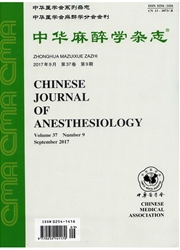

 中文摘要:
中文摘要:
目的建立鞘内注射利多卡因致大鼠神经损伤模型。方法成年雄性SD大鼠55只,体重200—220g,采用随机数字表法,将其随机分为5组(n=11):正常对照组(C组)、溶媒组(D组)、5%利多卡因组(k组)、10%利多卡因组(L10组)和15%利多卡因组(L15组)。D组、L5组、L10组和L15分别鞘内注射二甲基亚砜、5%、10%、15%利多卡因20m。五组各取8只大鼠,分别于鞘内给药前(基础状态)、给药后1、2、3、4、5、7d时进行后肢运动功能障碍评分,并测定机械缩足反应阈值(MWT)和热缩足潜伏期(TWL)。五组各取3只大鼠,于鞘内给药后1d时处死,取脊髓L1-5节段,光镜下观察脊髓组织病理学结果。结果与C组比较,D组和L5组运动功能障碍评分、MWT和TWL差异无统计学意义(P〉0.05),L10组给药后1、2d时MWT升高,TWL延长(P〈0.05);L15组给药后1、2d时运动功能障碍评分升高,给药后1、2、3d时MWT升高,TWL延长(P〈0.05)。L10组和L15组脊髓组织病理学损伤明显。结论鞘内注射10%利多卡因适合用于建立大鼠神经损伤模型。
 英文摘要:
英文摘要:
Objective To establish a rat model of nerve damage induced by intrathecal (IT) lidocaine. Methods Fifty-five adult male SD rats weighing 200-220 g were randomly divided into 5 groups ( n = 11 each) : group normal control (group C) ; group dimethyl sulfoxide (DMSO)-the solvent(group D) and groups IT 5%, 10%, 15% lidocaine (groups L5,10,15 ). IT catheter was successfully implanted without complication in groups D, L5, Ll0, L15 . DMSO, 5%, 10% and 15% lidocaine 20 μl were injected IT in groups D,L5 , L10, L15 respectively. Motor dysfunction of hindlimb was assessed and scored (0 = normal, 2 = complete block) and paw withdrawal threshold to mechanical stimulation (yon Frey filaments) (MWT) and paw withdrawal latency to thermal nociceptive stimulus (TWL) were measured before (baseline) and at 1, 2, 3, 4, 5, 7 d after IT administration in 8 animals in each group. Three animals in each group were sacrificed at 1 d after IT administration. The lumbar segment (L1-5)was removed for microscopic examination. Results There was no significant difference in motor dysfunction score, MWT and TWL among groups C, D and L5. MWT was significantly increased and TWL prolonged at 1 and 2 d after IT administration in group Lt0, while in group L15 motor dysfunction score was significantly increased at 1, 2 d after IT administration and MWT was significantly increased and TWL prolonged at 1, 2, 3 d after IT administration. There was significant histologic damage to spinal cord in groups L10 and L15 . Conclusion Nerve damage can be induced by IT 10% lidocaine.
 同期刊论文项目
同期刊论文项目
 同项目期刊论文
同项目期刊论文
 期刊信息
期刊信息
